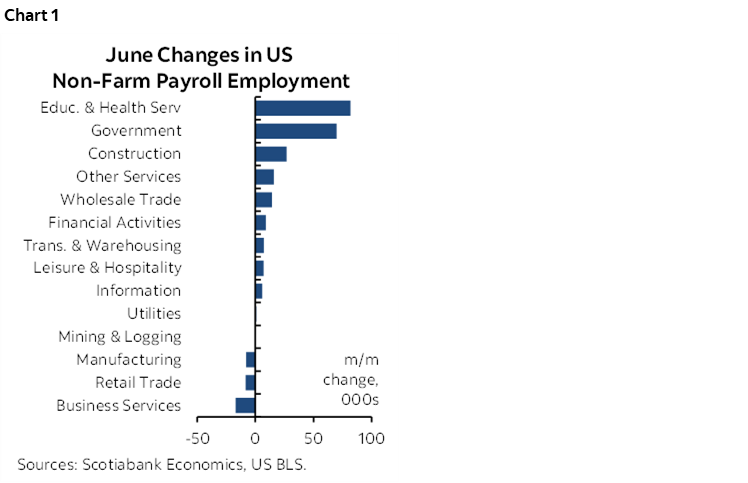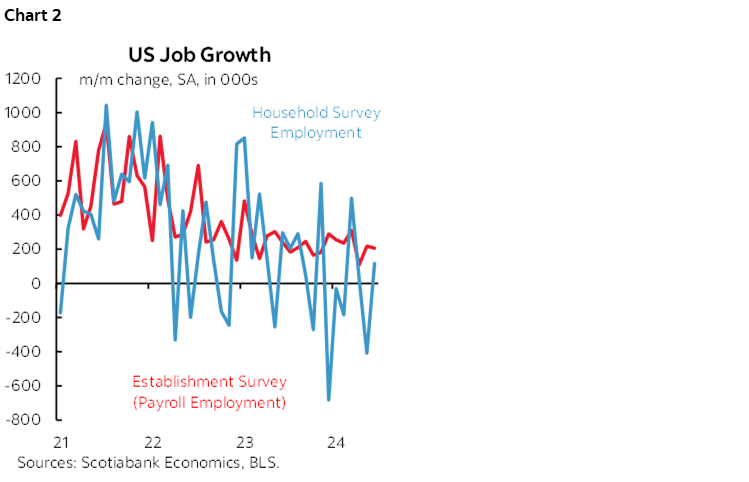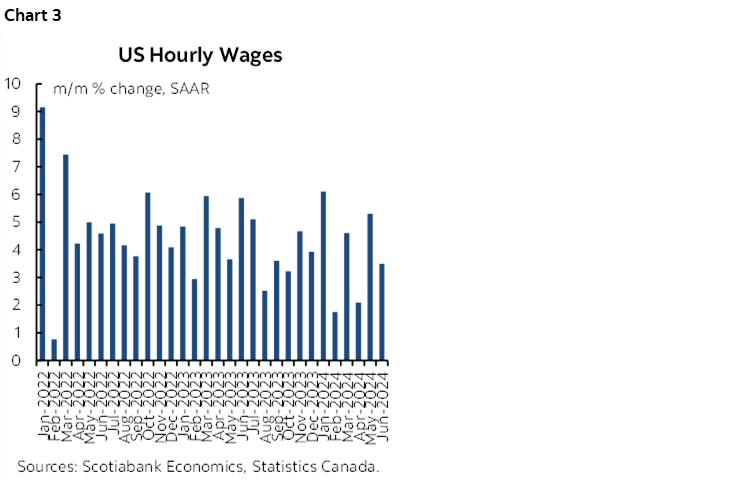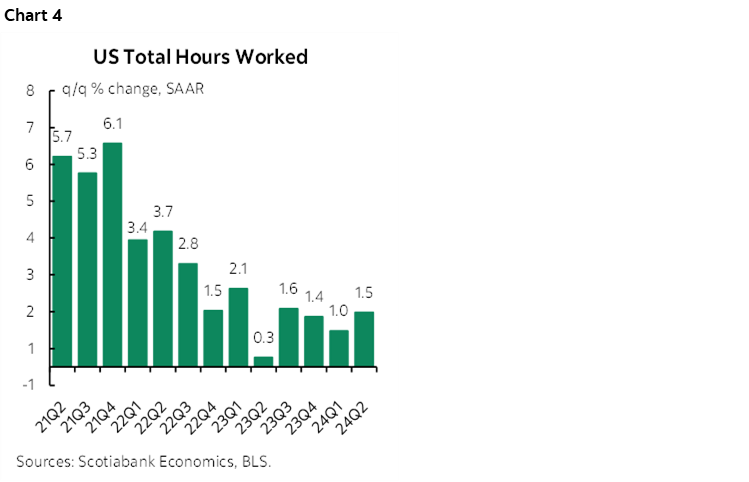- Nonfarm payrolls, m/m 000s // UR %, June, SA:
- Actual: 206 / 4.1
- Scotia: 210 / 3.9
- Consensus: 190 / 4.0
- Prior: 218 / 4.0 ( revised from 272 / 4.0)
Job growth cooled and the composition was soft. Broader details also softened. Treasury yields fell by about 7bps in 2s and 5bps in 10s while the USD broadly depreciated.
Markets continue to assign no chance at a cut later this month but have about 20bps pricing for the September meeting when we forecast a first cut. Markets added a few more basis points to cumulative cuts later this year into early next and are aligned with our forecast for 50bps of easing this year. The S&P is outperforming other global benchmarks.
206k jobs created in nonfarm payrolls is nothing to be overly negative about. The composition was soft, however, as it was led by government jobs (+70k m/m) almost entirely at the state and local levels, and the education and health sectors (chart 1). There was relatively little growth in other sectors.

Furthermore, the more volatile companion household survey registered a job gain of just 116k which was a tepid rebound from the prior month’s decline of 408k. The household survey differs from nonfarm for several reasons including that it captures off-payroll employment, counts multiple job holders once, and has a much higher degree of random statistical noise. The unemployment rate ticked up to 4.1% as the labour force (+277k) grew faster than jobs.
The trend in job growth is off the peak, holding fairly steady for nonfarm but trending weaker in the much noisier household survey (chart 2).

Also note that revisions were negative. They shaved 111k jobs off the prior two months with about a 50–50 split over the two months.
Wage growth remains solid at 0.3% m/m SA and 3.5% m/m SAAR, but it cooled a touch from the prior month’s pace (chart 3).

Hours worked are tracking mild growth. They were only up by 1.5% q/q SAAR in Q2 which extends the string of 1-handled increases (chart 4). Since GDP is hours times labour productivity, the US needs productivity growth to drive strong growth but nowcasts for Q2 GDP growth point to a deceleration toward 1 1/2 % q/q SAAR after just 1.4% growth in Q1.

On their own, these numbers mean relatively little to the FOMC. They are clearly on hold until at least September and evaluating much further data between now and then.
DISCLAIMER
This report has been prepared by Scotiabank Economics as a resource for the clients of Scotiabank. Opinions, estimates and projections contained herein are our own as of the date hereof and are subject to change without notice. The information and opinions contained herein have been compiled or arrived at from sources believed reliable but no representation or warranty, express or implied, is made as to their accuracy or completeness. Neither Scotiabank nor any of its officers, directors, partners, employees or affiliates accepts any liability whatsoever for any direct or consequential loss arising from any use of this report or its contents.
These reports are provided to you for informational purposes only. This report is not, and is not constructed as, an offer to sell or solicitation of any offer to buy any financial instrument, nor shall this report be construed as an opinion as to whether you should enter into any swap or trading strategy involving a swap or any other transaction. The information contained in this report is not intended to be, and does not constitute, a recommendation of a swap or trading strategy involving a swap within the meaning of U.S. Commodity Futures Trading Commission Regulation 23.434 and Appendix A thereto. This material is not intended to be individually tailored to your needs or characteristics and should not be viewed as a “call to action” or suggestion that you enter into a swap or trading strategy involving a swap or any other transaction. Scotiabank may engage in transactions in a manner inconsistent with the views discussed this report and may have positions, or be in the process of acquiring or disposing of positions, referred to in this report.
Scotiabank, its affiliates and any of their respective officers, directors and employees may from time to time take positions in currencies, act as managers, co-managers or underwriters of a public offering or act as principals or agents, deal in, own or act as market makers or advisors, brokers or commercial and/or investment bankers in relation to securities or related derivatives. As a result of these actions, Scotiabank may receive remuneration. All Scotiabank products and services are subject to the terms of applicable agreements and local regulations. Officers, directors and employees of Scotiabank and its affiliates may serve as directors of corporations.
Any securities discussed in this report may not be suitable for all investors. Scotiabank recommends that investors independently evaluate any issuer and security discussed in this report, and consult with any advisors they deem necessary prior to making any investment.
This report and all information, opinions and conclusions contained in it are protected by copyright. This information may not be reproduced without the prior express written consent of Scotiabank.
™ Trademark of The Bank of Nova Scotia. Used under license, where applicable.
Scotiabank, together with “Global Banking and Markets”, is a marketing name for the global corporate and investment banking and capital markets businesses of The Bank of Nova Scotia and certain of its affiliates in the countries where they operate, including; Scotiabank Europe plc; Scotiabank (Ireland) Designated Activity Company; Scotiabank Inverlat S.A., Institución de Banca Múltiple, Grupo Financiero Scotiabank Inverlat, Scotia Inverlat Casa de Bolsa, S.A. de C.V., Grupo Financiero Scotiabank Inverlat, Scotia Inverlat Derivados S.A. de C.V. – all members of the Scotiabank group and authorized users of the Scotiabank mark. The Bank of Nova Scotia is incorporated in Canada with limited liability and is authorised and regulated by the Office of the Superintendent of Financial Institutions Canada. The Bank of Nova Scotia is authorized by the UK Prudential Regulation Authority and is subject to regulation by the UK Financial Conduct Authority and limited regulation by the UK Prudential Regulation Authority. Details about the extent of The Bank of Nova Scotia's regulation by the UK Prudential Regulation Authority are available from us on request. Scotiabank Europe plc is authorized by the UK Prudential Regulation Authority and regulated by the UK Financial Conduct Authority and the UK Prudential Regulation Authority.
Scotiabank Inverlat, S.A., Scotia Inverlat Casa de Bolsa, S.A. de C.V, Grupo Financiero Scotiabank Inverlat, and Scotia Inverlat Derivados, S.A. de C.V., are each authorized and regulated by the Mexican financial authorities.
Not all products and services are offered in all jurisdictions. Services described are available in jurisdictions where permitted by law.

